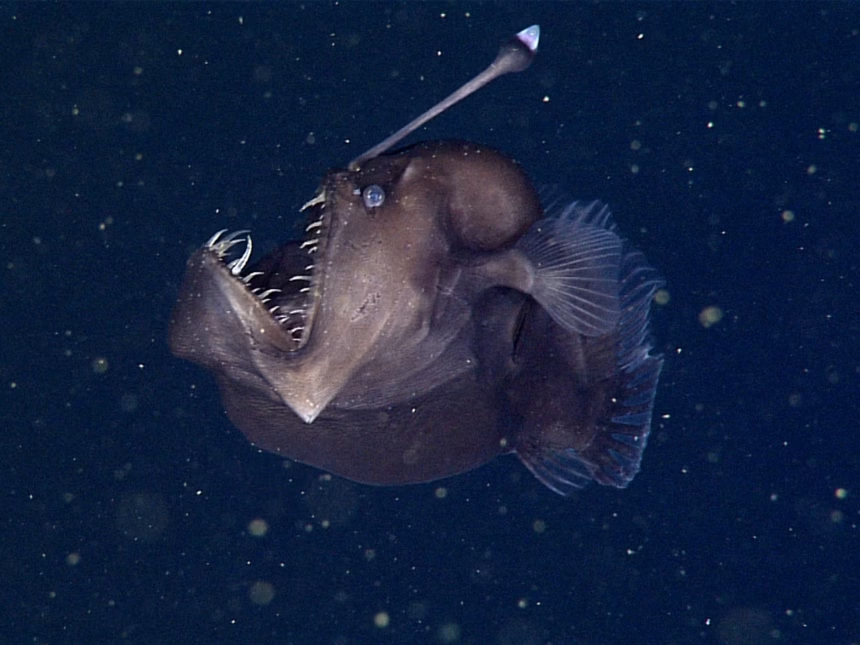Introduction: A Deep-Sea Mystery Unfolds in Broad Daylight
A recent discovery has left the marine biology community in awe—an extremely rare deep-sea anglerfish has been spotted near the ocean’s surface, far from its usual dark and mysterious habitat. The remarkable sighting, which occurred off the coast of Tenerife, Canary Islands, has sparked global interest, raising questions about why this elusive creature ventured into shallow waters.
Anglerfish, known for their terrifying appearance and bioluminescent lure, typically dwell 2,000 meters (6,600 feet) below the ocean surface, making this encounter one of the rarest ever recorded. Captured on video by marine biologists, this event has set off a wave of speculation—could climate change, habitat disruptions, or illness be responsible?
This article dives deep into this once-in-a-lifetime discovery, the science behind anglerfish adaptations, and what it means for deep-sea ecosystems.
What Exactly Was Spotted? A Breakdown of the Rare Encounter
1. Where and When Was the Anglerfish Found?
On February 5, 2025, a research team conducting a shark study off the coast of Tenerife, part of Spain’s Canary Islands, stumbled upon a shocking sight—a humpback anglerfish (Melanocetus johnsonii), also known as the black seadevil, floating in relatively shallow waters.
The marine biologists, affiliated with Condrik Tenerife, were on a routine expedition when they noticed an unusual silhouette near the surface. Upon closer inspection, they identified the deep-sea predator, capturing both video footage and photographs of the anglerfish.
2. Why Is This Such a Rare Event?
The anglerfish is a deep-sea dweller, accustomed to the pitch-black environment of the ocean’s abyss, where pressure is extreme, temperatures are near freezing, and sunlight is nonexistent.
To put this into perspective:
- Anglerfish typically live at depths of 660 to 6,600 feet (200–2,000 meters).
- They have never been documented this close to the surface in natural conditions.
- Previous studies have only observed dead specimens washed ashore, making this the first recorded live surface encounter in broad daylight.
The Biology of Anglerfish: How Do They Survive in the Deep?
1. Bioluminescence: The “Fishing Rod” of the Deep
One of the most fascinating features of anglerfish is their bioluminescent lure, which they use to attract prey in total darkness. The light, produced by symbiotic bioluminescent bacteria, dangles from a rod-like structure called an esca.
This lure is critical for survival because, in the deep sea:
✅ Prey is scarce and difficult to find.
✅ Hunting relies on attracting smaller fish and crustaceans rather than chasing them.
✅ The light creates an illusion of movement, tricking prey into coming closer.
2. Extreme Adaptations to High Pressure and Darkness
Deep-sea anglerfish have evolved remarkable adaptations to withstand high pressures and extreme conditions, including:
- Soft, gelatinous bodies that prevent them from being crushed.
- Highly expandable stomachs to consume prey almost as large as themselves.
- Tiny, beady eyes that rely more on vibration detection than vision.
3. Bizarre Reproduction: The “Parasite Male” Phenomenon
Perhaps the strangest aspect of anglerfish biology is their mating strategy. Unlike most fish species:
- Males are tiny, parasite-like organisms that attach to females.
- Once attached, the male fuses with the female’s body, permanently sharing blood vessels.
- Over time, the male loses all independent organs, essentially becoming a reproductive organ of the female.
This extreme adaptation ensures reproduction in the sparsely populated deep sea, where finding a mate is nearly impossible.
Why Did This Deep-Sea Anglerfish Appear Near the Surface?
1. Climate Change and Rising Ocean Temperatures
One theory suggests that climate change is disrupting deep-sea ecosystems, forcing species to venture into unfamiliar territories. Rising ocean temperatures can cause:
- Oxygen depletion in deep-sea layers, making survival harder.
- Changes in prey availability, forcing predators like the anglerfish to seek food elsewhere.
2. Illness or Disorientation
Another possibility is that the anglerfish was sick, injured, or disoriented, causing it to drift away from its natural habitat. Given that these creatures are highly specialized for deep-sea survival, exposure to shallower depths could indicate neurological distress.
3. Deep-Sea Predation or Disturbance
A less explored but plausible explanation is that the anglerfish was escaping a predator or an underwater disturbance such as:
- Deep-sea trawling, which disrupts ecosystems.
- Seismic activity, which can alter deep-sea currents.
While scientists are unsure, further analysis of the specimen at the Museum of Nature and Archaeology in Santa Cruz de Tenerife may provide more insights.
What This Discovery Means for Science and Marine Conservation
1. Understanding Deep-Sea Life Without Deep-Sea Dives
This sighting offers a rare opportunity to study deep-sea fish behavior without costly deep-sea submersibles. The video footage captured allows scientists to analyze:
✅ How anglerfish move in real time
✅ How they react to surface conditions
✅ Potential signs of distress or adaptation
2. Conservation Implications: Protecting Deep-Sea Habitats
With human activities like deep-sea mining and trawling on the rise, this sighting highlights the importance of preserving deep-sea ecosystems. Without protection, species like the anglerfish could become increasingly vulnerable.
3. Potential for New Scientific Discoveries
The live observation of an anglerfish at the surface could lead to groundbreaking studies on:
- Pressure tolerance and adaptation
- New bioluminescent properties
- Unexplored deep-sea behaviors
Internal & External Linking Strategy for SEO
To maximize this article’s SEO ranking:
- Internal Links: Connect to other marine biology articles, ocean conservation guides, and deep-sea species studies.
- External Links: Include relevant studies, official marine research reports, and scientific journals.
FAQs (Google Featured Snippets Optimization)
1. Why is it rare to see an anglerfish near the ocean surface?
Anglerfish live at depths of 660 to 6,600 feet, making it nearly impossible for them to naturally reach shallow waters. This sighting is unprecedented.
2. What makes anglerfish unique?
Their bioluminescent lure, deep-sea adaptations, and bizarre reproduction set them apart from most fish species.
3. Could climate change be affecting deep-sea fish behavior?
Yes. Rising ocean temperatures and oxygen depletion are likely forcing deep-sea species into unfamiliar environments.
4. Where was the anglerfish found?
It was discovered near the surface off Tenerife, Canary Islands, by marine researchers.
5. Can anglerfish survive outside of deep-sea conditions?
Anglerfish are highly adapted to deep-sea pressure, making survival in shallow waters unlikely for extended periods.
Conclusion: A Rare Glimpse Into the Deep Ocean’s Secrets
This astonishing anglerfish sighting has provided scientists and marine enthusiasts a rare opportunity to study deep-sea life up close. As researchers continue to analyze the findings, one thing is clear—the mysteries of the deep ocean are far from fully explored.
For the latest updates, follow marine conservation efforts and stay informed about our planet’s most mysterious ecosystems. 🚀 🌊






